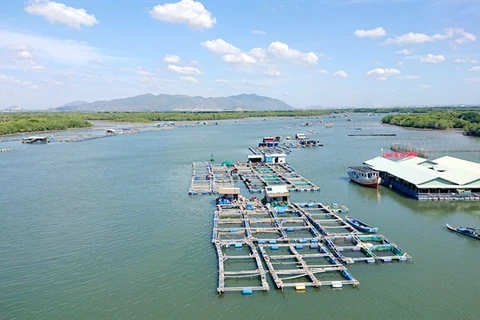Hanoi (VNA) – Aquaculture has grown rapidly in Asia in the past three decades with the main impetus for the industry’s surge being the stagnant wild fish catch, which has leveled off at a little above 80 million tonnes since the 1980s, according to Japanese economists.
In their recent joint article on development prospect of the aquaculture industry in Asia, Takashi Yamano Senior Economist at the Economic Research and Regional Cooperation Department of the Asian Development Bank (ADB), and Aya Suzuki, Development Economist and Professor at the University of Tokyo, said that private actors played important roles in the growth of shrimp aquaculture in Asian countries, such as Vietnam, strengthening the supply side and expanding global demand as a result.
According to the article, shrimp farming became widespread after technological innovation intensified the industry in the 1980s. The employment generated in aquaculture is substantial and rising, providing more work for women than the male-dominated wild capture fisheries.
Vietnam is an interesting case study. In 2000, Vietnam allowed the conversion of rice fields to fishponds. Initially, shrimp exports from the country were met with high rejection rates in importing countries, with high antibiotic residue in the product often cited as the main reason. After collaborative efforts of producers, traders, and government agencies, the rejection rates for shrimp exports from Vietnam have declined. The Southeast Asian nation is now one of the world’s largest shrimp producers.
However, the article noted that the aquaculture industry is also facing environmental sustainability concerns.
The environmental challenges facing aquaculture include land salinisation, land subsidence from overuse of groundwater, frequent outbreaks of shrimp and fish diseases under intensified farming methods, misuse of prohibited antibiotics, destruction of mangroves, and dependence on wild fish catch for feed, which depletes marine resources.
Amid challenges, efforts have been taken to mitigate the negative impact on the environment. Producer groups share technical and marketing information on social networks. Experienced producers, experts, and academics share tips and check for inappropriate information on these groups. Digital applications on mobile phones are now available for checking the health status of aquaculture products through their photos.
Digital technology use can help promote inclusive growth by providing affordable access to technical information and market access to farmers in remote areas, the article said.
Aquaculture production in Asia needs to keep up with the increasing demand while ensuring the sustainability of the growth, the two experts said. They proposed several recommendations to increase the sustainability of the aquaculture industry in the region, the experts stressed.
It is necessary to ensure that fish farmers follow good practices, governments and supporting organisations should actively use digital technology.
Some rules and monitoring schemes on the use of water should be put in place, preferably by crop and fish farmers themselves, and more research should be conducted on fish farming practices which are appropriate for the small-scale farmers’ environments, they said.
The COVID-19 pandemic has made it clear that former aquaculture practices are not sustainable going forward. Therefore, putting the right policies and practices in place will help support fish farmers and the millions of people in Asia and the Pacific who rely on fish to feed their families./.

Ba Ria – Vung Tau protects its valuable marine resources
The southern province of Ba Ria – Vung Tau is protecting seafood resources and developing aquaculture sustainably, with local authorities preventing destructive fishing activities and encouraging farmers to apply advanced techniques.























